International Marketing Report: Primark's Entry into the Indian Market
VerifiedAdded on 2020/02/05
|9
|2606
|150
Report
AI Summary
This report analyzes Primark's international marketing strategy, focusing on its potential entry into the Indian market. It begins with an executive summary and an introduction to international marketing, followed by a background on Primark and the clothing industry. The report utilizes PESTLE analysis to evaluate the political, economic, social, technological, legal, and environmental factors influencing Primark's competitive environment. It also explores market entry strategies such as direct export, licensing, franchising, and partnerships, with a recommendation for a franchisee model. A SWOT analysis identifies the company's strengths, weaknesses, opportunities, and threats. The report includes a problem identification section using root cause analysis to address declining sales, and concludes with a discussion of the marketing mix (product, price, place, and promotion) tailored for the Indian market. The report emphasizes the importance of adapting to local customer needs and climate considerations.
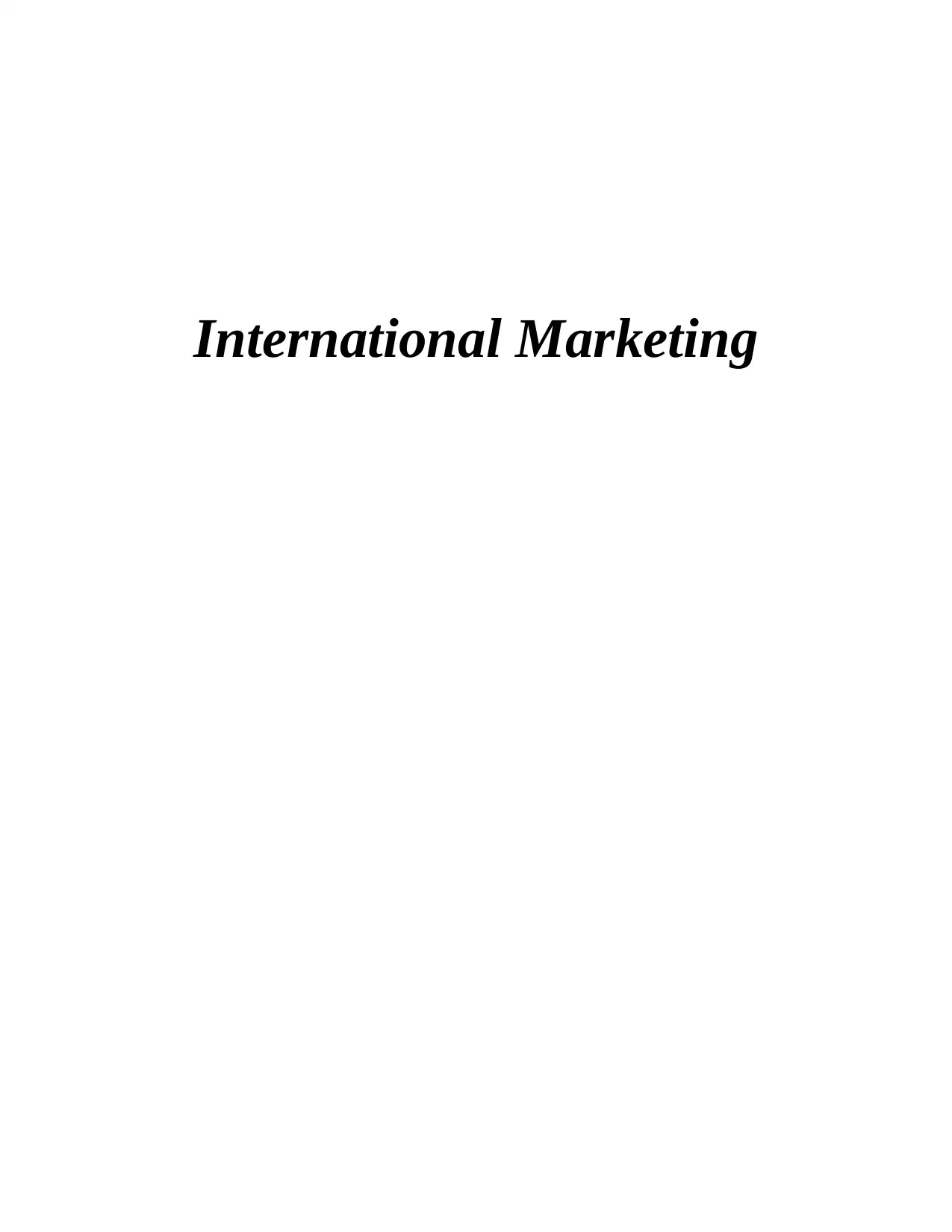
International Marketing
Paraphrase This Document
Need a fresh take? Get an instant paraphrase of this document with our AI Paraphraser
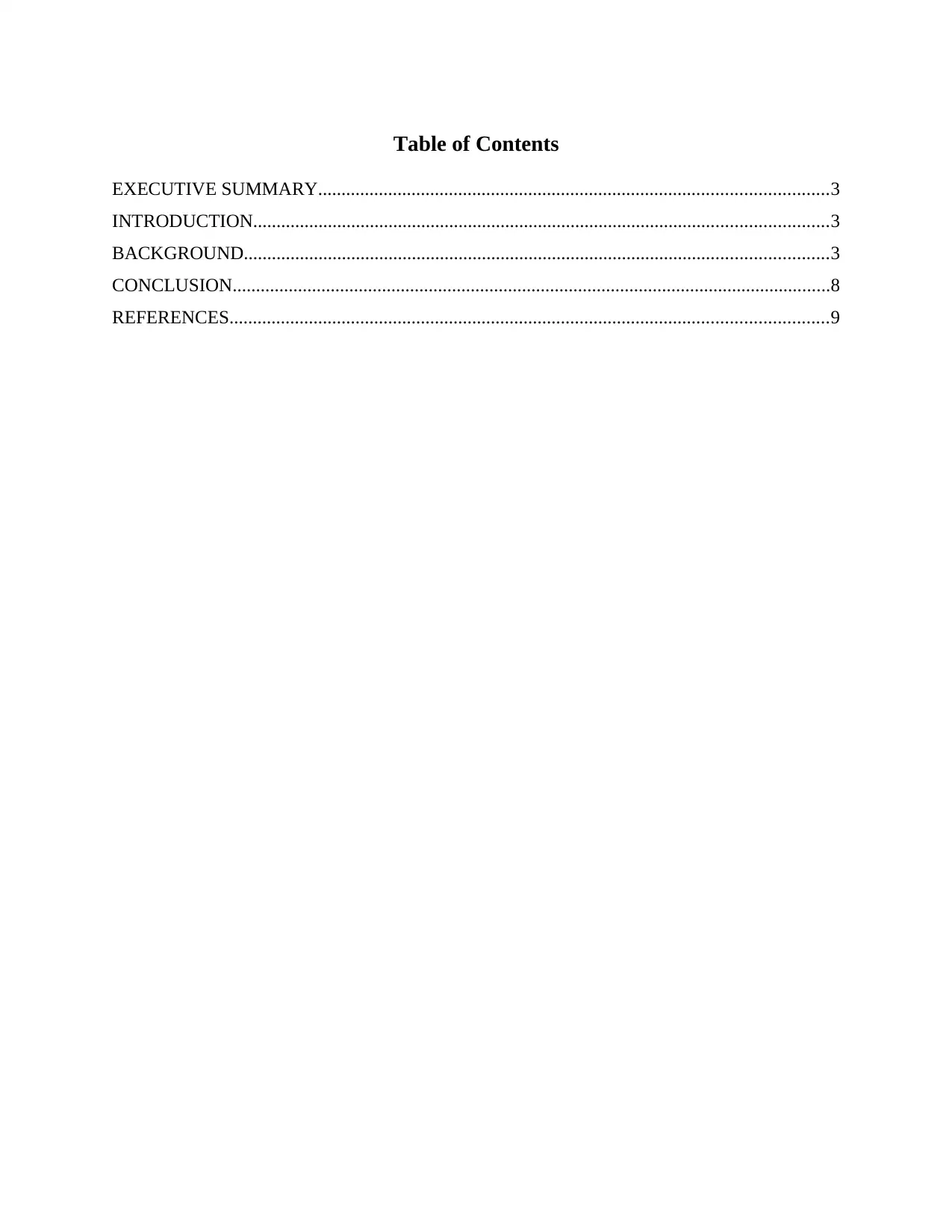
Table of Contents
EXECUTIVE SUMMARY.............................................................................................................3
INTRODUCTION...........................................................................................................................3
BACKGROUND.............................................................................................................................3
CONCLUSION................................................................................................................................8
REFERENCES................................................................................................................................9
EXECUTIVE SUMMARY.............................................................................................................3
INTRODUCTION...........................................................................................................................3
BACKGROUND.............................................................................................................................3
CONCLUSION................................................................................................................................8
REFERENCES................................................................................................................................9
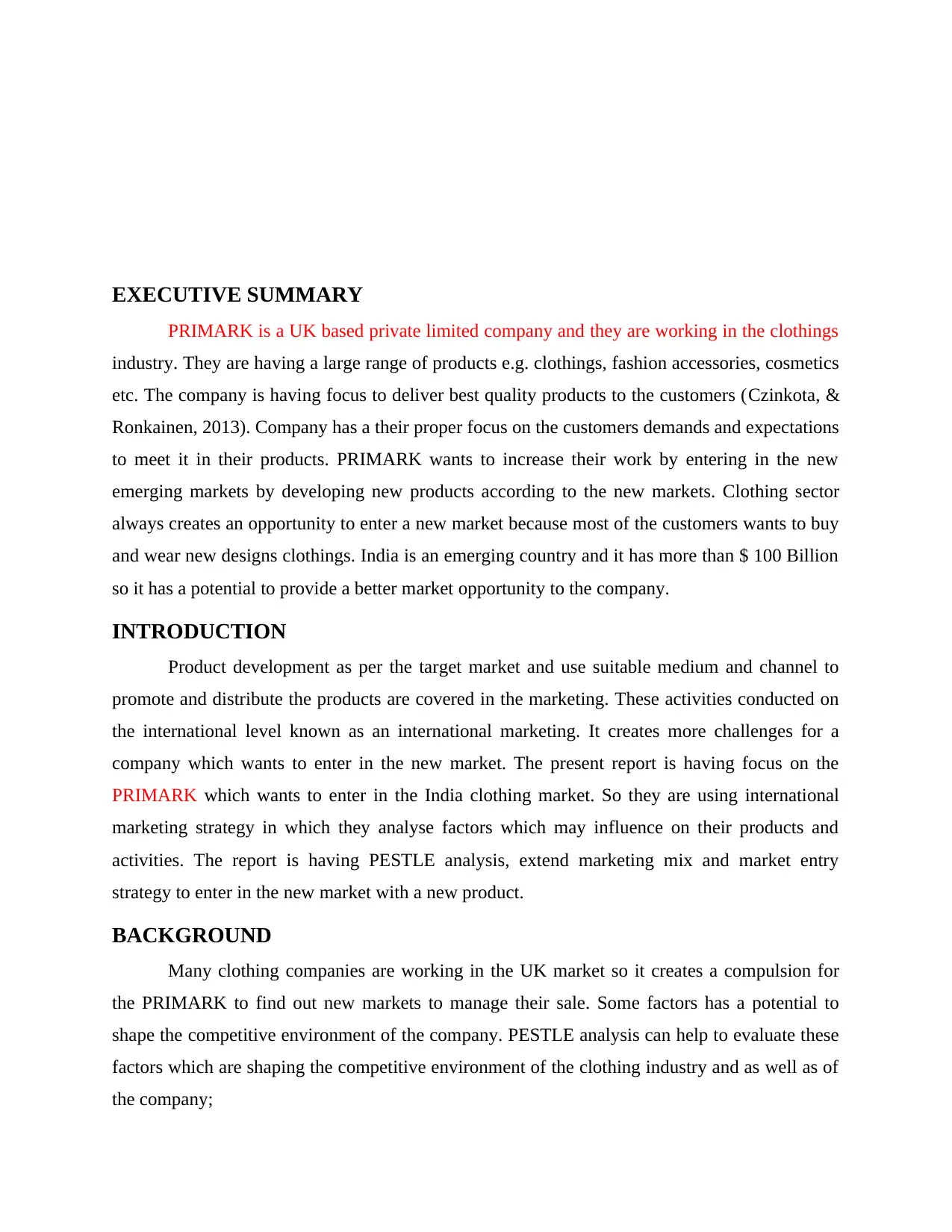
EXECUTIVE SUMMARY
PRIMARK is a UK based private limited company and they are working in the clothings
industry. They are having a large range of products e.g. clothings, fashion accessories, cosmetics
etc. The company is having focus to deliver best quality products to the customers (Czinkota, &
Ronkainen, 2013). Company has a their proper focus on the customers demands and expectations
to meet it in their products. PRIMARK wants to increase their work by entering in the new
emerging markets by developing new products according to the new markets. Clothing sector
always creates an opportunity to enter a new market because most of the customers wants to buy
and wear new designs clothings. India is an emerging country and it has more than $ 100 Billion
so it has a potential to provide a better market opportunity to the company.
INTRODUCTION
Product development as per the target market and use suitable medium and channel to
promote and distribute the products are covered in the marketing. These activities conducted on
the international level known as an international marketing. It creates more challenges for a
company which wants to enter in the new market. The present report is having focus on the
PRIMARK which wants to enter in the India clothing market. So they are using international
marketing strategy in which they analyse factors which may influence on their products and
activities. The report is having PESTLE analysis, extend marketing mix and market entry
strategy to enter in the new market with a new product.
BACKGROUND
Many clothing companies are working in the UK market so it creates a compulsion for
the PRIMARK to find out new markets to manage their sale. Some factors has a potential to
shape the competitive environment of the company. PESTLE analysis can help to evaluate these
factors which are shaping the competitive environment of the clothing industry and as well as of
the company;
PRIMARK is a UK based private limited company and they are working in the clothings
industry. They are having a large range of products e.g. clothings, fashion accessories, cosmetics
etc. The company is having focus to deliver best quality products to the customers (Czinkota, &
Ronkainen, 2013). Company has a their proper focus on the customers demands and expectations
to meet it in their products. PRIMARK wants to increase their work by entering in the new
emerging markets by developing new products according to the new markets. Clothing sector
always creates an opportunity to enter a new market because most of the customers wants to buy
and wear new designs clothings. India is an emerging country and it has more than $ 100 Billion
so it has a potential to provide a better market opportunity to the company.
INTRODUCTION
Product development as per the target market and use suitable medium and channel to
promote and distribute the products are covered in the marketing. These activities conducted on
the international level known as an international marketing. It creates more challenges for a
company which wants to enter in the new market. The present report is having focus on the
PRIMARK which wants to enter in the India clothing market. So they are using international
marketing strategy in which they analyse factors which may influence on their products and
activities. The report is having PESTLE analysis, extend marketing mix and market entry
strategy to enter in the new market with a new product.
BACKGROUND
Many clothing companies are working in the UK market so it creates a compulsion for
the PRIMARK to find out new markets to manage their sale. Some factors has a potential to
shape the competitive environment of the company. PESTLE analysis can help to evaluate these
factors which are shaping the competitive environment of the clothing industry and as well as of
the company;
⊘ This is a preview!⊘
Do you want full access?
Subscribe today to unlock all pages.

Trusted by 1+ million students worldwide
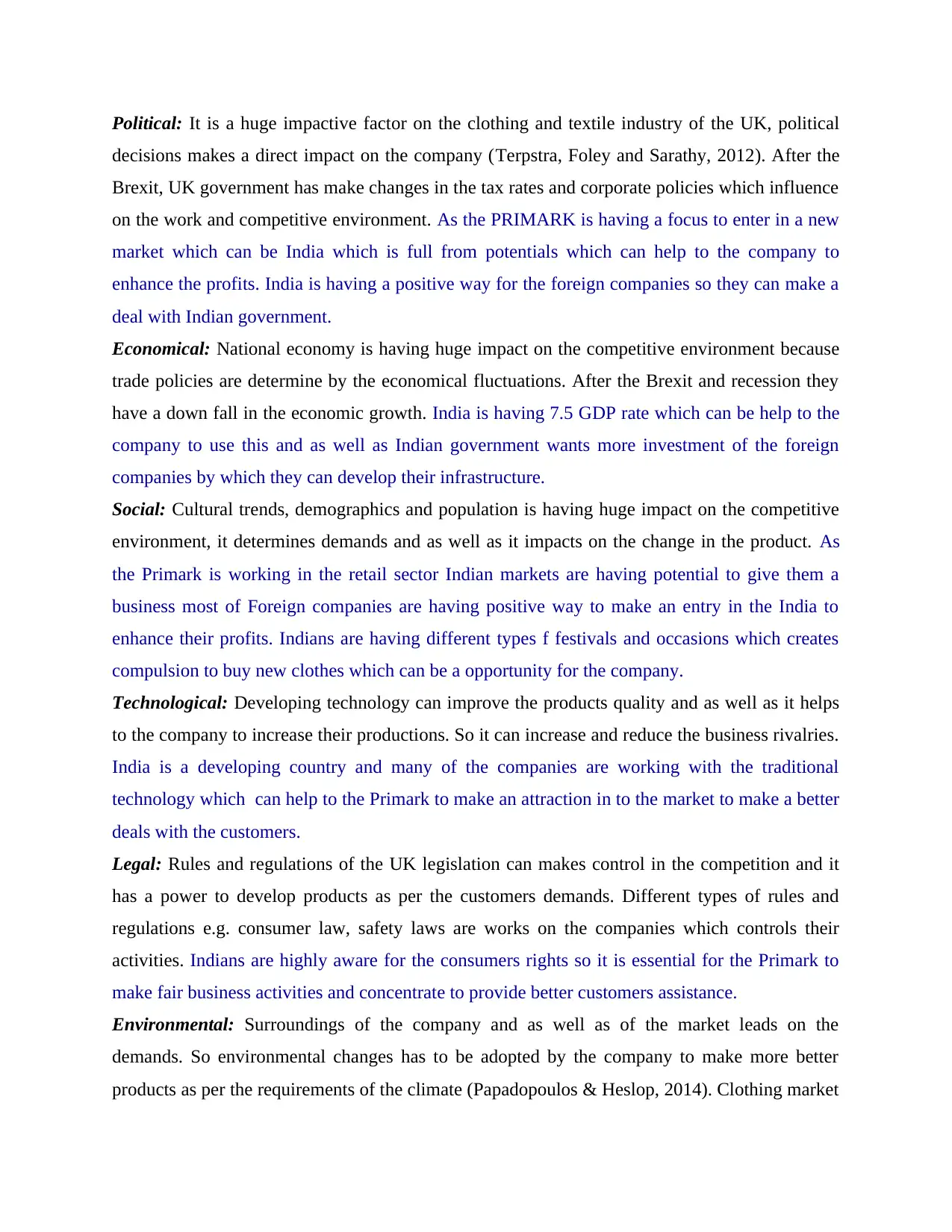
Political: It is a huge impactive factor on the clothing and textile industry of the UK, political
decisions makes a direct impact on the company (Terpstra, Foley and Sarathy, 2012). After the
Brexit, UK government has make changes in the tax rates and corporate policies which influence
on the work and competitive environment. As the PRIMARK is having a focus to enter in a new
market which can be India which is full from potentials which can help to the company to
enhance the profits. India is having a positive way for the foreign companies so they can make a
deal with Indian government.
Economical: National economy is having huge impact on the competitive environment because
trade policies are determine by the economical fluctuations. After the Brexit and recession they
have a down fall in the economic growth. India is having 7.5 GDP rate which can be help to the
company to use this and as well as Indian government wants more investment of the foreign
companies by which they can develop their infrastructure.
Social: Cultural trends, demographics and population is having huge impact on the competitive
environment, it determines demands and as well as it impacts on the change in the product. As
the Primark is working in the retail sector Indian markets are having potential to give them a
business most of Foreign companies are having positive way to make an entry in the India to
enhance their profits. Indians are having different types f festivals and occasions which creates
compulsion to buy new clothes which can be a opportunity for the company.
Technological: Developing technology can improve the products quality and as well as it helps
to the company to increase their productions. So it can increase and reduce the business rivalries.
India is a developing country and many of the companies are working with the traditional
technology which can help to the Primark to make an attraction in to the market to make a better
deals with the customers.
Legal: Rules and regulations of the UK legislation can makes control in the competition and it
has a power to develop products as per the customers demands. Different types of rules and
regulations e.g. consumer law, safety laws are works on the companies which controls their
activities. Indians are highly aware for the consumers rights so it is essential for the Primark to
make fair business activities and concentrate to provide better customers assistance.
Environmental: Surroundings of the company and as well as of the market leads on the
demands. So environmental changes has to be adopted by the company to make more better
products as per the requirements of the climate (Papadopoulos & Heslop, 2014). Clothing market
decisions makes a direct impact on the company (Terpstra, Foley and Sarathy, 2012). After the
Brexit, UK government has make changes in the tax rates and corporate policies which influence
on the work and competitive environment. As the PRIMARK is having a focus to enter in a new
market which can be India which is full from potentials which can help to the company to
enhance the profits. India is having a positive way for the foreign companies so they can make a
deal with Indian government.
Economical: National economy is having huge impact on the competitive environment because
trade policies are determine by the economical fluctuations. After the Brexit and recession they
have a down fall in the economic growth. India is having 7.5 GDP rate which can be help to the
company to use this and as well as Indian government wants more investment of the foreign
companies by which they can develop their infrastructure.
Social: Cultural trends, demographics and population is having huge impact on the competitive
environment, it determines demands and as well as it impacts on the change in the product. As
the Primark is working in the retail sector Indian markets are having potential to give them a
business most of Foreign companies are having positive way to make an entry in the India to
enhance their profits. Indians are having different types f festivals and occasions which creates
compulsion to buy new clothes which can be a opportunity for the company.
Technological: Developing technology can improve the products quality and as well as it helps
to the company to increase their productions. So it can increase and reduce the business rivalries.
India is a developing country and many of the companies are working with the traditional
technology which can help to the Primark to make an attraction in to the market to make a better
deals with the customers.
Legal: Rules and regulations of the UK legislation can makes control in the competition and it
has a power to develop products as per the customers demands. Different types of rules and
regulations e.g. consumer law, safety laws are works on the companies which controls their
activities. Indians are highly aware for the consumers rights so it is essential for the Primark to
make fair business activities and concentrate to provide better customers assistance.
Environmental: Surroundings of the company and as well as of the market leads on the
demands. So environmental changes has to be adopted by the company to make more better
products as per the requirements of the climate (Papadopoulos & Heslop, 2014). Clothing market
Paraphrase This Document
Need a fresh take? Get an instant paraphrase of this document with our AI Paraphraser
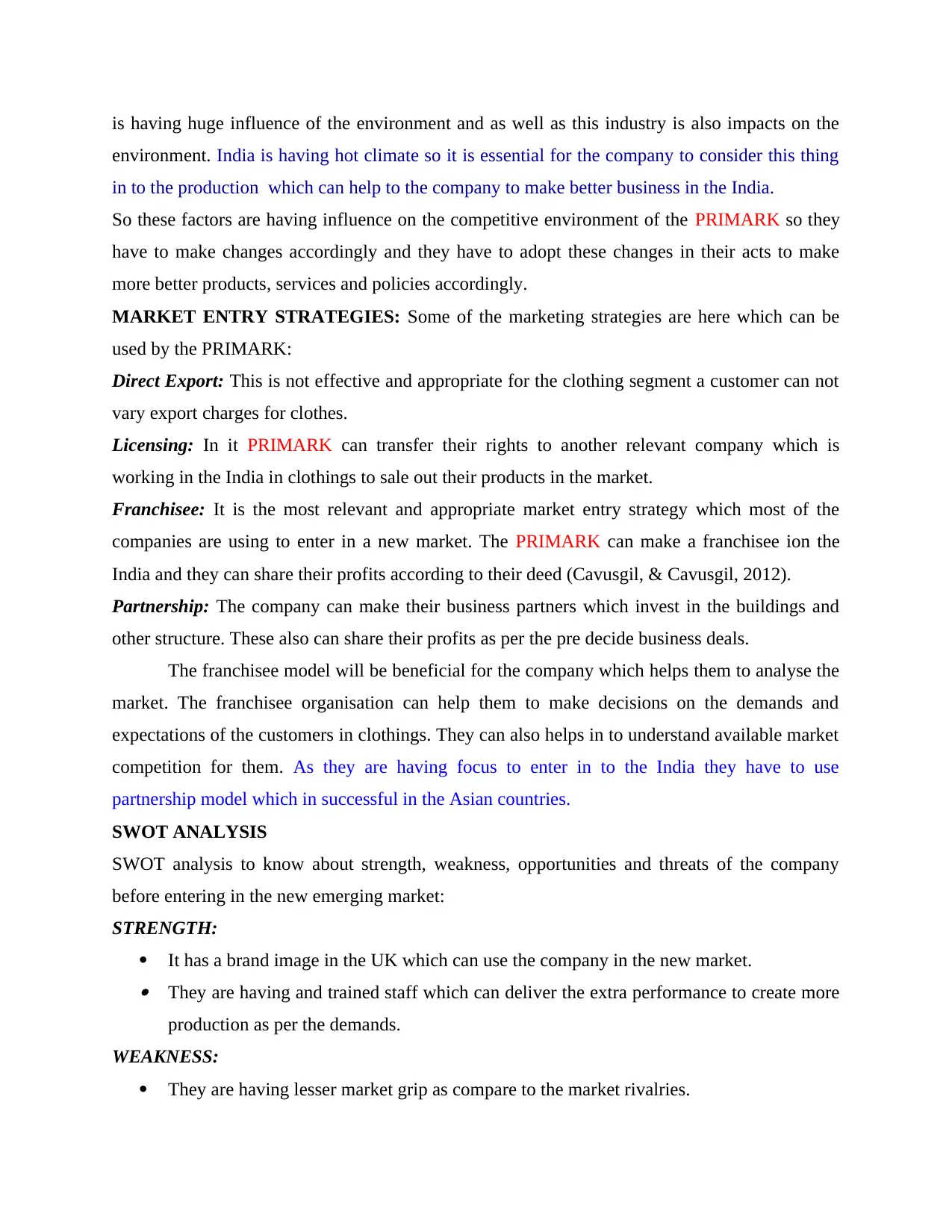
is having huge influence of the environment and as well as this industry is also impacts on the
environment. India is having hot climate so it is essential for the company to consider this thing
in to the production which can help to the company to make better business in the India.
So these factors are having influence on the competitive environment of the PRIMARK so they
have to make changes accordingly and they have to adopt these changes in their acts to make
more better products, services and policies accordingly.
MARKET ENTRY STRATEGIES: Some of the marketing strategies are here which can be
used by the PRIMARK:
Direct Export: This is not effective and appropriate for the clothing segment a customer can not
vary export charges for clothes.
Licensing: In it PRIMARK can transfer their rights to another relevant company which is
working in the India in clothings to sale out their products in the market.
Franchisee: It is the most relevant and appropriate market entry strategy which most of the
companies are using to enter in a new market. The PRIMARK can make a franchisee ion the
India and they can share their profits according to their deed (Cavusgil, & Cavusgil, 2012).
Partnership: The company can make their business partners which invest in the buildings and
other structure. These also can share their profits as per the pre decide business deals.
The franchisee model will be beneficial for the company which helps them to analyse the
market. The franchisee organisation can help them to make decisions on the demands and
expectations of the customers in clothings. They can also helps in to understand available market
competition for them. As they are having focus to enter in to the India they have to use
partnership model which in successful in the Asian countries.
SWOT ANALYSIS
SWOT analysis to know about strength, weakness, opportunities and threats of the company
before entering in the new emerging market:
STRENGTH:
It has a brand image in the UK which can use the company in the new market. They are having and trained staff which can deliver the extra performance to create more
production as per the demands.
WEAKNESS:
They are having lesser market grip as compare to the market rivalries.
environment. India is having hot climate so it is essential for the company to consider this thing
in to the production which can help to the company to make better business in the India.
So these factors are having influence on the competitive environment of the PRIMARK so they
have to make changes accordingly and they have to adopt these changes in their acts to make
more better products, services and policies accordingly.
MARKET ENTRY STRATEGIES: Some of the marketing strategies are here which can be
used by the PRIMARK:
Direct Export: This is not effective and appropriate for the clothing segment a customer can not
vary export charges for clothes.
Licensing: In it PRIMARK can transfer their rights to another relevant company which is
working in the India in clothings to sale out their products in the market.
Franchisee: It is the most relevant and appropriate market entry strategy which most of the
companies are using to enter in a new market. The PRIMARK can make a franchisee ion the
India and they can share their profits according to their deed (Cavusgil, & Cavusgil, 2012).
Partnership: The company can make their business partners which invest in the buildings and
other structure. These also can share their profits as per the pre decide business deals.
The franchisee model will be beneficial for the company which helps them to analyse the
market. The franchisee organisation can help them to make decisions on the demands and
expectations of the customers in clothings. They can also helps in to understand available market
competition for them. As they are having focus to enter in to the India they have to use
partnership model which in successful in the Asian countries.
SWOT ANALYSIS
SWOT analysis to know about strength, weakness, opportunities and threats of the company
before entering in the new emerging market:
STRENGTH:
It has a brand image in the UK which can use the company in the new market. They are having and trained staff which can deliver the extra performance to create more
production as per the demands.
WEAKNESS:
They are having lesser market grip as compare to the market rivalries.
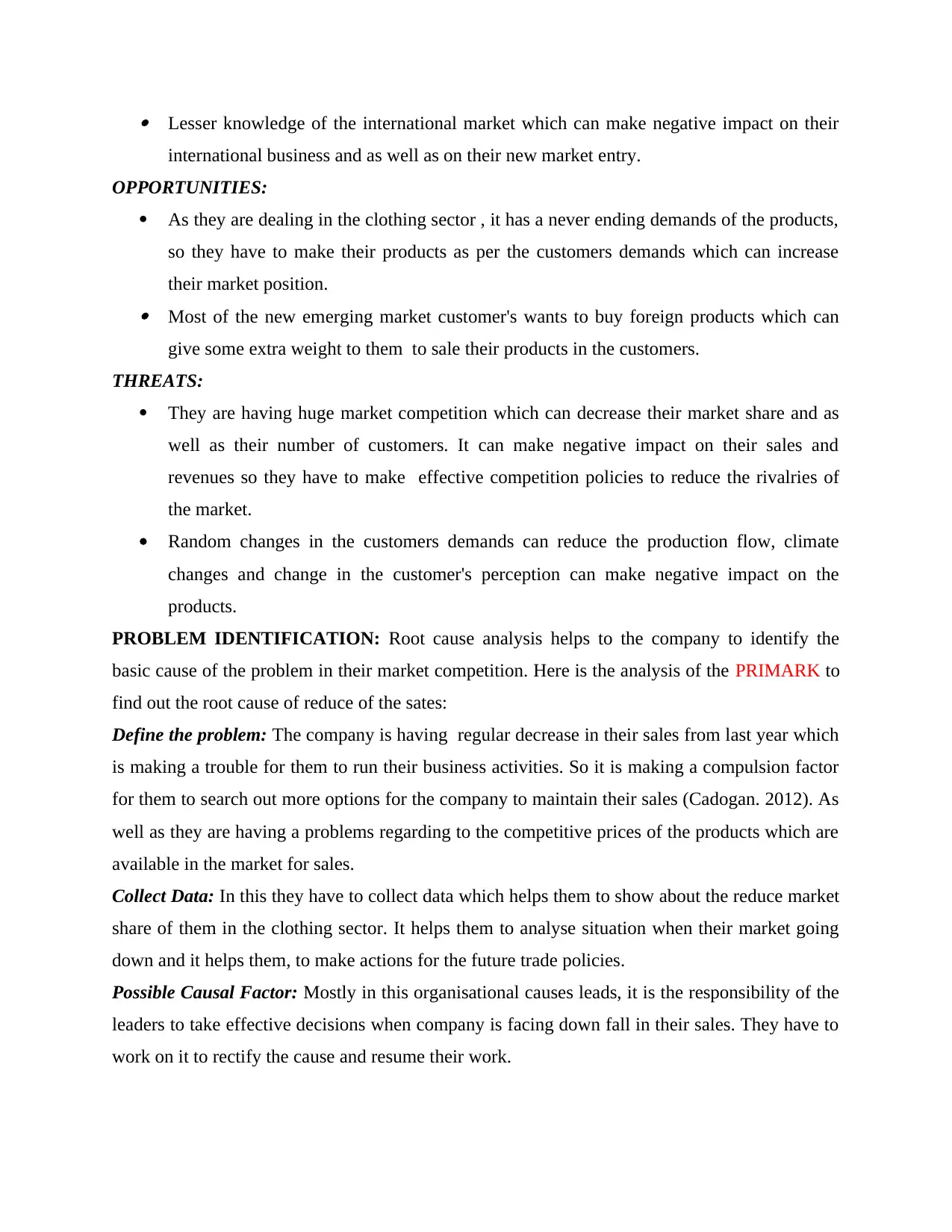
Lesser knowledge of the international market which can make negative impact on their
international business and as well as on their new market entry.
OPPORTUNITIES:
As they are dealing in the clothing sector , it has a never ending demands of the products,
so they have to make their products as per the customers demands which can increase
their market position. Most of the new emerging market customer's wants to buy foreign products which can
give some extra weight to them to sale their products in the customers.
THREATS:
They are having huge market competition which can decrease their market share and as
well as their number of customers. It can make negative impact on their sales and
revenues so they have to make effective competition policies to reduce the rivalries of
the market.
Random changes in the customers demands can reduce the production flow, climate
changes and change in the customer's perception can make negative impact on the
products.
PROBLEM IDENTIFICATION: Root cause analysis helps to the company to identify the
basic cause of the problem in their market competition. Here is the analysis of the PRIMARK to
find out the root cause of reduce of the sates:
Define the problem: The company is having regular decrease in their sales from last year which
is making a trouble for them to run their business activities. So it is making a compulsion factor
for them to search out more options for the company to maintain their sales (Cadogan. 2012). As
well as they are having a problems regarding to the competitive prices of the products which are
available in the market for sales.
Collect Data: In this they have to collect data which helps them to show about the reduce market
share of them in the clothing sector. It helps them to analyse situation when their market going
down and it helps them, to make actions for the future trade policies.
Possible Causal Factor: Mostly in this organisational causes leads, it is the responsibility of the
leaders to take effective decisions when company is facing down fall in their sales. They have to
work on it to rectify the cause and resume their work.
international business and as well as on their new market entry.
OPPORTUNITIES:
As they are dealing in the clothing sector , it has a never ending demands of the products,
so they have to make their products as per the customers demands which can increase
their market position. Most of the new emerging market customer's wants to buy foreign products which can
give some extra weight to them to sale their products in the customers.
THREATS:
They are having huge market competition which can decrease their market share and as
well as their number of customers. It can make negative impact on their sales and
revenues so they have to make effective competition policies to reduce the rivalries of
the market.
Random changes in the customers demands can reduce the production flow, climate
changes and change in the customer's perception can make negative impact on the
products.
PROBLEM IDENTIFICATION: Root cause analysis helps to the company to identify the
basic cause of the problem in their market competition. Here is the analysis of the PRIMARK to
find out the root cause of reduce of the sates:
Define the problem: The company is having regular decrease in their sales from last year which
is making a trouble for them to run their business activities. So it is making a compulsion factor
for them to search out more options for the company to maintain their sales (Cadogan. 2012). As
well as they are having a problems regarding to the competitive prices of the products which are
available in the market for sales.
Collect Data: In this they have to collect data which helps them to show about the reduce market
share of them in the clothing sector. It helps them to analyse situation when their market going
down and it helps them, to make actions for the future trade policies.
Possible Causal Factor: Mostly in this organisational causes leads, it is the responsibility of the
leaders to take effective decisions when company is facing down fall in their sales. They have to
work on it to rectify the cause and resume their work.
⊘ This is a preview!⊘
Do you want full access?
Subscribe today to unlock all pages.

Trusted by 1+ million students worldwide
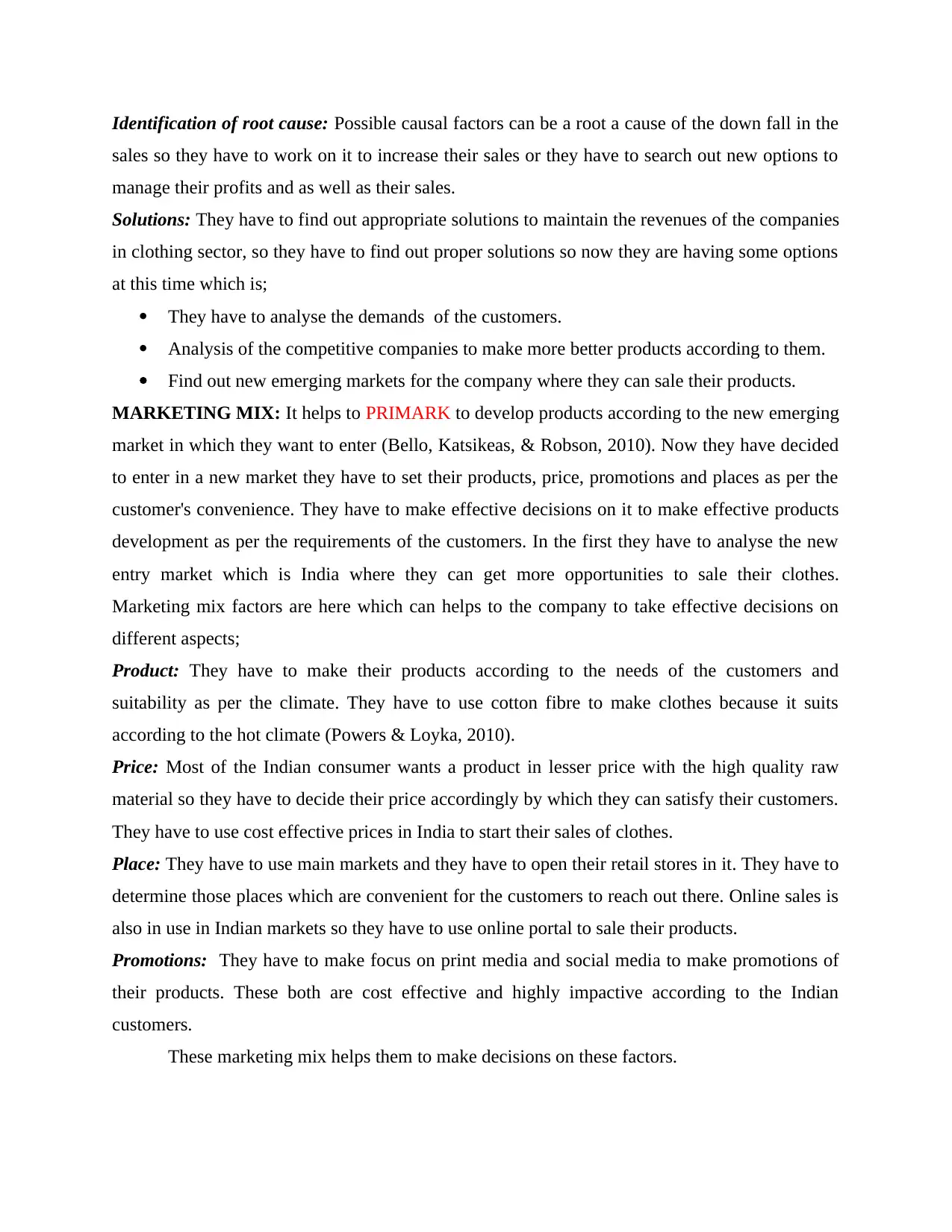
Identification of root cause: Possible causal factors can be a root a cause of the down fall in the
sales so they have to work on it to increase their sales or they have to search out new options to
manage their profits and as well as their sales.
Solutions: They have to find out appropriate solutions to maintain the revenues of the companies
in clothing sector, so they have to find out proper solutions so now they are having some options
at this time which is;
They have to analyse the demands of the customers.
Analysis of the competitive companies to make more better products according to them.
Find out new emerging markets for the company where they can sale their products.
MARKETING MIX: It helps to PRIMARK to develop products according to the new emerging
market in which they want to enter (Bello, Katsikeas, & Robson, 2010). Now they have decided
to enter in a new market they have to set their products, price, promotions and places as per the
customer's convenience. They have to make effective decisions on it to make effective products
development as per the requirements of the customers. In the first they have to analyse the new
entry market which is India where they can get more opportunities to sale their clothes.
Marketing mix factors are here which can helps to the company to take effective decisions on
different aspects;
Product: They have to make their products according to the needs of the customers and
suitability as per the climate. They have to use cotton fibre to make clothes because it suits
according to the hot climate (Powers & Loyka, 2010).
Price: Most of the Indian consumer wants a product in lesser price with the high quality raw
material so they have to decide their price accordingly by which they can satisfy their customers.
They have to use cost effective prices in India to start their sales of clothes.
Place: They have to use main markets and they have to open their retail stores in it. They have to
determine those places which are convenient for the customers to reach out there. Online sales is
also in use in Indian markets so they have to use online portal to sale their products.
Promotions: They have to make focus on print media and social media to make promotions of
their products. These both are cost effective and highly impactive according to the Indian
customers.
These marketing mix helps them to make decisions on these factors.
sales so they have to work on it to increase their sales or they have to search out new options to
manage their profits and as well as their sales.
Solutions: They have to find out appropriate solutions to maintain the revenues of the companies
in clothing sector, so they have to find out proper solutions so now they are having some options
at this time which is;
They have to analyse the demands of the customers.
Analysis of the competitive companies to make more better products according to them.
Find out new emerging markets for the company where they can sale their products.
MARKETING MIX: It helps to PRIMARK to develop products according to the new emerging
market in which they want to enter (Bello, Katsikeas, & Robson, 2010). Now they have decided
to enter in a new market they have to set their products, price, promotions and places as per the
customer's convenience. They have to make effective decisions on it to make effective products
development as per the requirements of the customers. In the first they have to analyse the new
entry market which is India where they can get more opportunities to sale their clothes.
Marketing mix factors are here which can helps to the company to take effective decisions on
different aspects;
Product: They have to make their products according to the needs of the customers and
suitability as per the climate. They have to use cotton fibre to make clothes because it suits
according to the hot climate (Powers & Loyka, 2010).
Price: Most of the Indian consumer wants a product in lesser price with the high quality raw
material so they have to decide their price accordingly by which they can satisfy their customers.
They have to use cost effective prices in India to start their sales of clothes.
Place: They have to use main markets and they have to open their retail stores in it. They have to
determine those places which are convenient for the customers to reach out there. Online sales is
also in use in Indian markets so they have to use online portal to sale their products.
Promotions: They have to make focus on print media and social media to make promotions of
their products. These both are cost effective and highly impactive according to the Indian
customers.
These marketing mix helps them to make decisions on these factors.
Paraphrase This Document
Need a fresh take? Get an instant paraphrase of this document with our AI Paraphraser
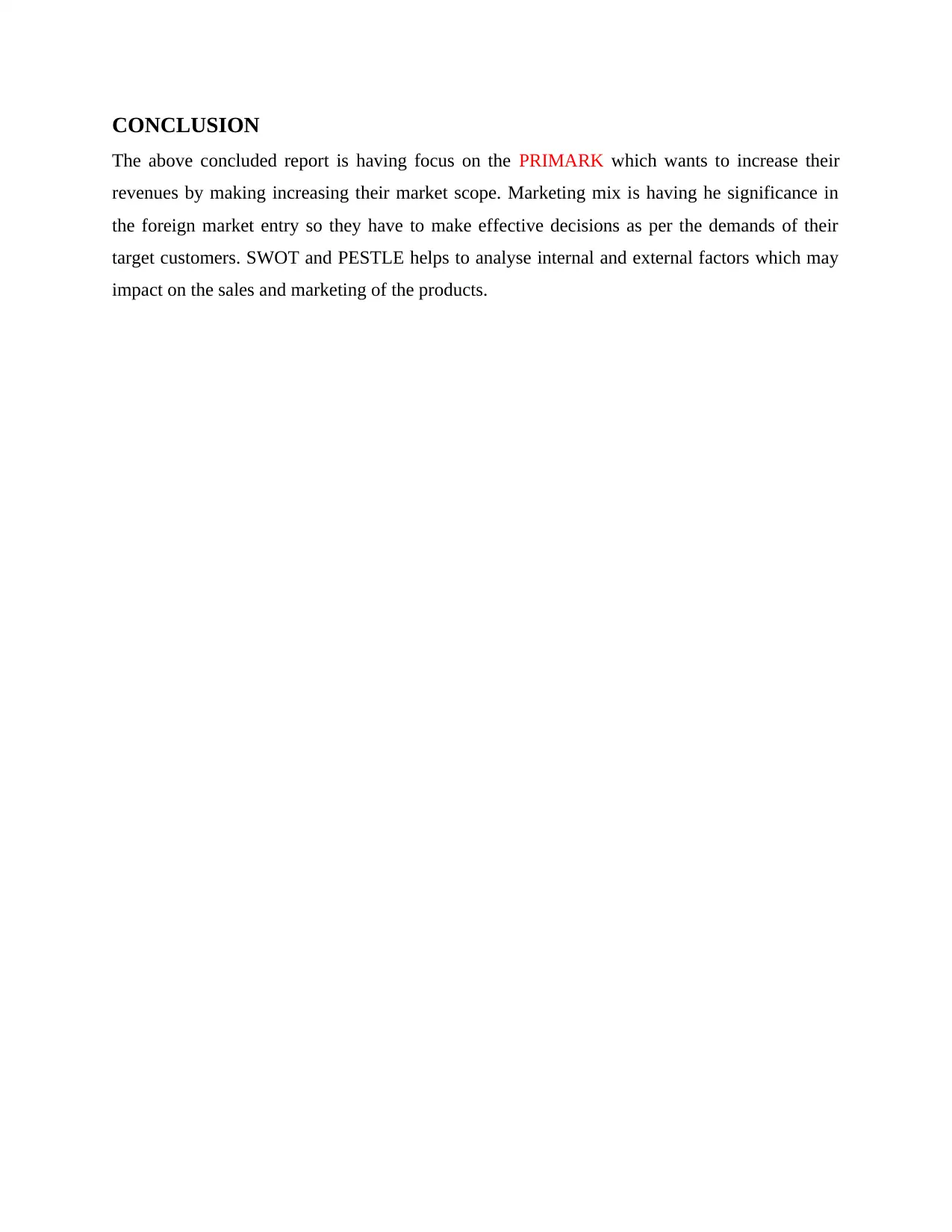
CONCLUSION
The above concluded report is having focus on the PRIMARK which wants to increase their
revenues by making increasing their market scope. Marketing mix is having he significance in
the foreign market entry so they have to make effective decisions as per the demands of their
target customers. SWOT and PESTLE helps to analyse internal and external factors which may
impact on the sales and marketing of the products.
The above concluded report is having focus on the PRIMARK which wants to increase their
revenues by making increasing their market scope. Marketing mix is having he significance in
the foreign market entry so they have to make effective decisions as per the demands of their
target customers. SWOT and PESTLE helps to analyse internal and external factors which may
impact on the sales and marketing of the products.
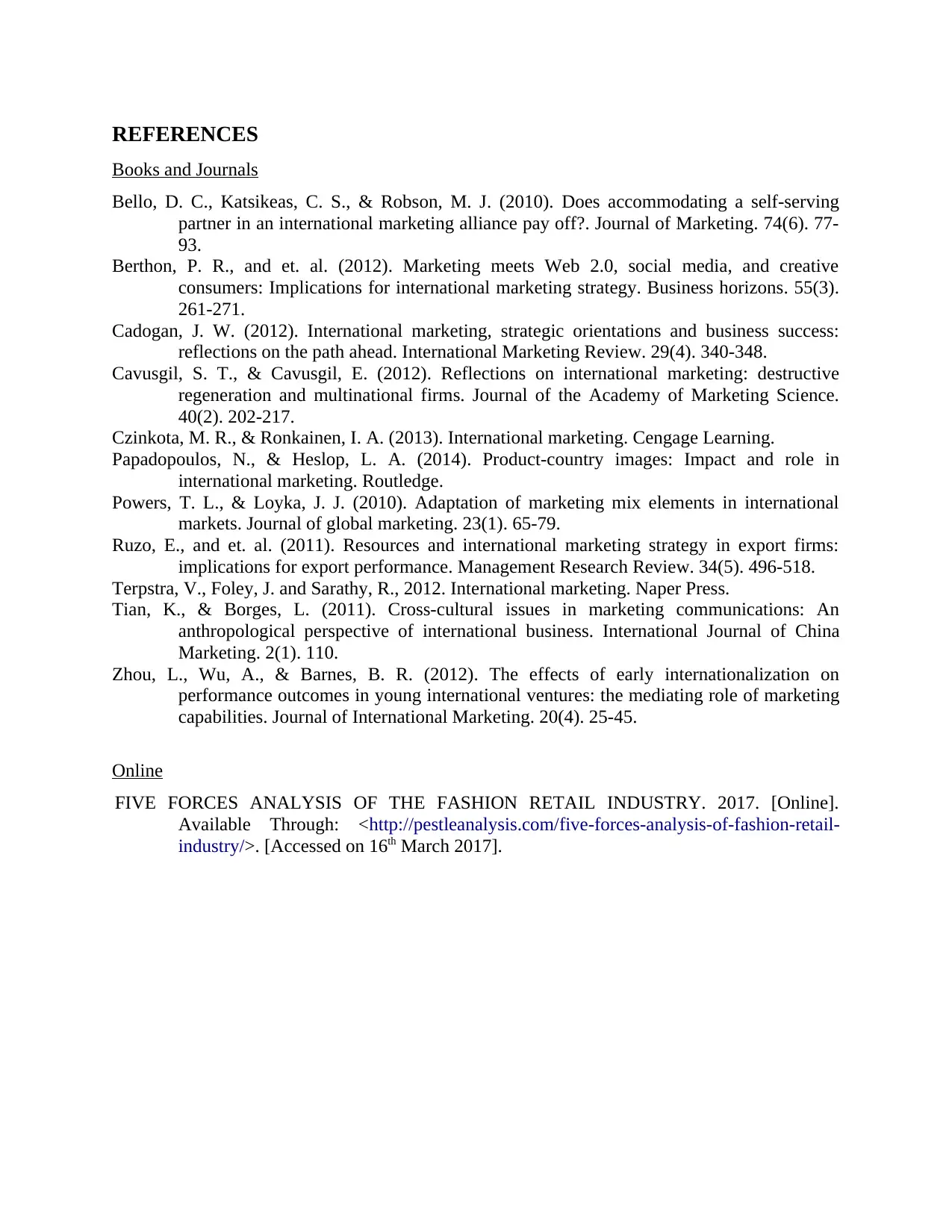
REFERENCES
Books and Journals
Bello, D. C., Katsikeas, C. S., & Robson, M. J. (2010). Does accommodating a self-serving
partner in an international marketing alliance pay off?. Journal of Marketing. 74(6). 77-
93.
Berthon, P. R., and et. al. (2012). Marketing meets Web 2.0, social media, and creative
consumers: Implications for international marketing strategy. Business horizons. 55(3).
261-271.
Cadogan, J. W. (2012). International marketing, strategic orientations and business success:
reflections on the path ahead. International Marketing Review. 29(4). 340-348.
Cavusgil, S. T., & Cavusgil, E. (2012). Reflections on international marketing: destructive
regeneration and multinational firms. Journal of the Academy of Marketing Science.
40(2). 202-217.
Czinkota, M. R., & Ronkainen, I. A. (2013). International marketing. Cengage Learning.
Papadopoulos, N., & Heslop, L. A. (2014). Product-country images: Impact and role in
international marketing. Routledge.
Powers, T. L., & Loyka, J. J. (2010). Adaptation of marketing mix elements in international
markets. Journal of global marketing. 23(1). 65-79.
Ruzo, E., and et. al. (2011). Resources and international marketing strategy in export firms:
implications for export performance. Management Research Review. 34(5). 496-518.
Terpstra, V., Foley, J. and Sarathy, R., 2012. International marketing. Naper Press.
Tian, K., & Borges, L. (2011). Cross-cultural issues in marketing communications: An
anthropological perspective of international business. International Journal of China
Marketing. 2(1). 110.
Zhou, L., Wu, A., & Barnes, B. R. (2012). The effects of early internationalization on
performance outcomes in young international ventures: the mediating role of marketing
capabilities. Journal of International Marketing. 20(4). 25-45.
Online
FIVE FORCES ANALYSIS OF THE FASHION RETAIL INDUSTRY. 2017. [Online].
Available Through: <http://pestleanalysis.com/five-forces-analysis-of-fashion-retail-
industry/>. [Accessed on 16th March 2017].
Books and Journals
Bello, D. C., Katsikeas, C. S., & Robson, M. J. (2010). Does accommodating a self-serving
partner in an international marketing alliance pay off?. Journal of Marketing. 74(6). 77-
93.
Berthon, P. R., and et. al. (2012). Marketing meets Web 2.0, social media, and creative
consumers: Implications for international marketing strategy. Business horizons. 55(3).
261-271.
Cadogan, J. W. (2012). International marketing, strategic orientations and business success:
reflections on the path ahead. International Marketing Review. 29(4). 340-348.
Cavusgil, S. T., & Cavusgil, E. (2012). Reflections on international marketing: destructive
regeneration and multinational firms. Journal of the Academy of Marketing Science.
40(2). 202-217.
Czinkota, M. R., & Ronkainen, I. A. (2013). International marketing. Cengage Learning.
Papadopoulos, N., & Heslop, L. A. (2014). Product-country images: Impact and role in
international marketing. Routledge.
Powers, T. L., & Loyka, J. J. (2010). Adaptation of marketing mix elements in international
markets. Journal of global marketing. 23(1). 65-79.
Ruzo, E., and et. al. (2011). Resources and international marketing strategy in export firms:
implications for export performance. Management Research Review. 34(5). 496-518.
Terpstra, V., Foley, J. and Sarathy, R., 2012. International marketing. Naper Press.
Tian, K., & Borges, L. (2011). Cross-cultural issues in marketing communications: An
anthropological perspective of international business. International Journal of China
Marketing. 2(1). 110.
Zhou, L., Wu, A., & Barnes, B. R. (2012). The effects of early internationalization on
performance outcomes in young international ventures: the mediating role of marketing
capabilities. Journal of International Marketing. 20(4). 25-45.
Online
FIVE FORCES ANALYSIS OF THE FASHION RETAIL INDUSTRY. 2017. [Online].
Available Through: <http://pestleanalysis.com/five-forces-analysis-of-fashion-retail-
industry/>. [Accessed on 16th March 2017].
⊘ This is a preview!⊘
Do you want full access?
Subscribe today to unlock all pages.

Trusted by 1+ million students worldwide
1 out of 9
Related Documents
Your All-in-One AI-Powered Toolkit for Academic Success.
+13062052269
info@desklib.com
Available 24*7 on WhatsApp / Email
![[object Object]](/_next/static/media/star-bottom.7253800d.svg)
Unlock your academic potential
Copyright © 2020–2025 A2Z Services. All Rights Reserved. Developed and managed by ZUCOL.





